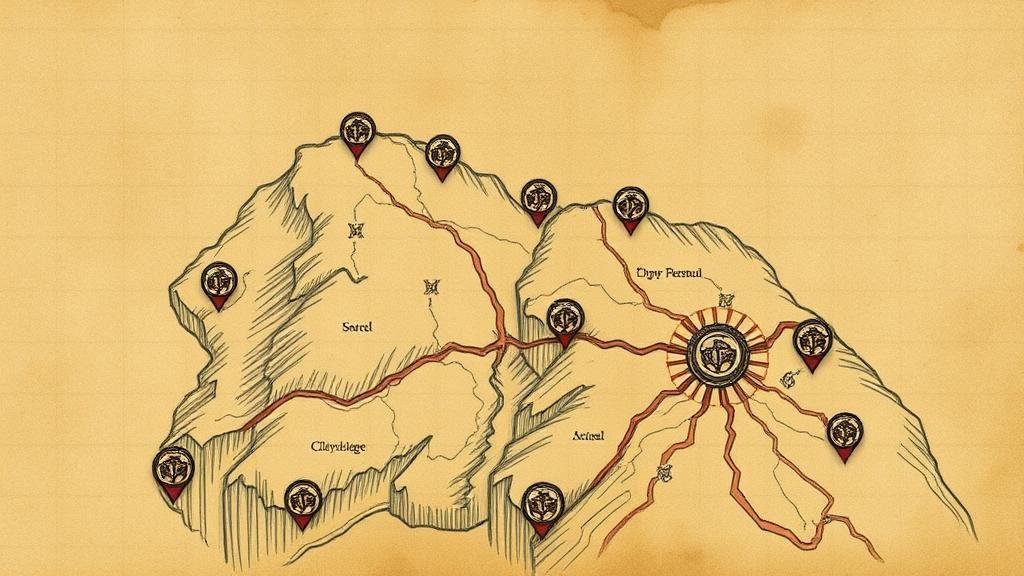Spotting Hidden Vault Symbols in Map Sketches of Cliffside Trails
Spotting Hidden Vault Symbols in Map Sketches of Cliffside Trails
Map sketches depicting cliffside trails often contain hidden symbols that can lead to valuable archaeological finds or safe passage routes. These symbols, while cryptic to the untrained eye, provide crucial insights into the landscapes history and the cultural significance of the trails. This article delves into identifying these hidden vault symbols, understanding their meanings, and utilizing them effectively for exploration or preservation purposes.
Understanding Vault Symbols
Vault symbols are graphical representations often used by explorers, cartographers, and historians to denote areas of interest on a map. can refer to hidden treasures, archaeological sites, or important geographical features. Typically, these symbols are stylized and may differ significantly from standard mapping conventions.
For example, a small triangle could signify a cave entrance, while an intricate spiral might mark a location considered sacred by indigenous peoples. In many historical maps, symbols can range from simple notations to elaborate illustrations that require deciphering skills.
- Unique Geometry: Symbols often leverage geometric shapes with specific meanings.
- Color Usage: Different colors can indicate various types of sites, such as red for significant historical markers or blue for water sources.
Deciphering Map Sketches
The process of deciphering map sketches involves a close inspection of various elements within the presentation. Here are key aspects to consider when analyzing sketches:
- Scale and Orientation: Determine how the map is oriented and its scale to understand the size and relative position of symbols.
- Contextual Clues: Look for surrounding features that can provide context to the symbols. For example, symbols adjacent to cliff outlines may indicate hidden pathways or exits.
Real-world applications of this technique can be seen in the work of archaeologists in regions rich in history, such as the cliff dwellings in the American Southwest. By studying old maps, researchers have been able to locate previously undiscovered dwellings or artifacts buried within cliff facades.
Notable Case Studies
Several case studies highlight the effective use of map sketches in identifying hidden vault symbols, enhancing our understanding of topographical narratives. Two prominent examples include:
- The Anasazi Trails: Researchers have deciphered ancient trail maps that led to cave dwellings, marking locations of ritual significance. Detailed analysis of geometric symbols helped archaeologists realize how the Anasazi used the surrounding landscape for ceremonial purposes.
- The Inca Road System: Studies of map sketches of Inca trails revealed hidden symbols connected to their vast and complex road systems. Some symbols corresponded to called “chaskis†(messenger waypoints), indicating provision points for travelers throughout treacherous mountain passes.
Challenges in Identification
Despite the opportunities these maps present, several challenges arise when identifying hidden vault symbols. Natural degradation, erosion, and human intervention can obscure markings over time. Here are some common issues faced:
- Fading Symbols: Many symbols may be worn away or faded, leading to misinterpretation.
- Overlapping Features: As new trails are built, they may obscure original symbols, complicating the identification process.
The challenges emphasize the importance of supplementary tools like advanced imaging technology and on-ground exploratory techniques. By utilizing drones and 3D scanning, researchers can uncover hidden details that traditional methods may overlook.
Actionable Takeaways
For those interested in spotting hidden vault symbols in cliffside trail maps, consider the following actionable steps:
- Study Various Map Types: Familiarize yourself with different styles of historical maps and their symbols.
- Engage in Field Research: Conduct field studies in areas rich in historical significance while applying your map analysis skills.
- Participate in Workshops: Join archaeological workshops or map-reading classes to hone your skills in symbol recognition and interpretation.
By actively engaging in these practices, you will develop a comprehensive understanding of how to spot hidden vault symbols and their significance in the broader context of geographical history and cultural preservation.



